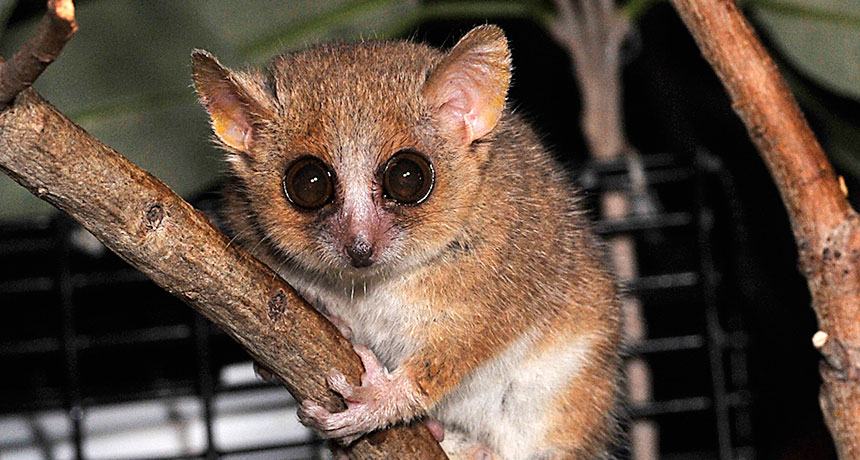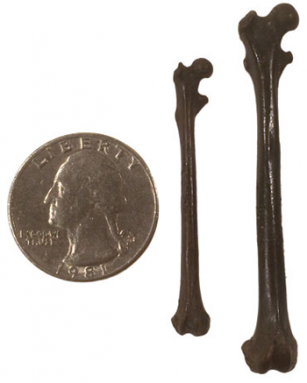Surprising primate fossils found in an Indian coal mine
Tiny, ancient bones hint India may have been a hotbed of early primate evolution

Scientists digging in an Indian coal mine found fossils of extinct primates that lived 54.5 million years ago. The animals were about the size of a gray mouse lemur (shown above).
David Haring/Duke Lemur Center
By Bruce Bower
Researchers have dug up remarkably ancient and well preserved bones in an Indian coal mine. The multi-million-year-old bones, those scientists say, come from rat-sized primates. They appear to have been close relatives of our distant ancestors. And finding them in India comes as something of a surprise.
Primates are mammals that include humans, apes, monkeys and related animals. Early primates were thought to have evolved largely on the continent of Africa. The new find suggests India also may have been a hotbed of early primate evolution.
The researchers share this conclusion in the October Journal of Human Evolution.
Doug Boyer is an evolutionary anthropologist — someone who studies the evolution of humankind. He works at Duke University in Durham, N.C. and wasn’t involved in the new study. In 2010, he and his colleagues reported on a roughly 65-million-year-old fossil found in southern India. They proposed it might be a close relative to the animal that gave rise to current-day primates, tree shrews and flying lemurs. (Flying lemurs glide rather than fly and are not true lemurs.) “It’s possible that India played an important role in primate evolution,” he now concludes.
Discovery in an Indian coal mine
The latest find comes out of a mine in Gujarat, India’s most western state. Evolutionary biologist Rachel Dunn works at Des Moines University in Iowa. She and her colleagues found a set of 25 arm, leg, ankle and foot fossils. All were roughly 54.5 million years old. The tiny tree-dwellers they came from resembled the first primates — animals that lived up to 65 million years ago.

Earlier, researchers digging in the same area — called the Vastan mine — turned up jaws, teeth and limb bones from four ancient primate species. Dunn and her colleagues’ new discovery adds to what scientists have been able to learn from this site.
“The Vastan primates probably approximate a common primate ancestor better than any fossils found previously,” says Kenneth Rose. One of the study’s authors, he’s a paleontologist — a fossil expert. He works at Johns Hopkins University School of Medicine in Baltimore, Md.
The Vastan animals were about the size of living gray mouse lemurs and dwarf lemurs. They likely weighed up to 300 grams (roughly two-thirds of a pound), the scientists estimate. Dunn’s group has posted 3-D scans of the fossils online (at morphosource.org). Doing that allows other researchers to download and study the data.
Most Vastan individuals possessed only a basic climbing ability. That sets them apart from the more specialized body types of the two ancient groups of primates that gave rise to present-day primates, the researchers say. One of those ancient groups is called omomyids. They consisted of relatives of modern tarsiers, monkeys and apes. The other group is called adapoids. These animals included relatives of current-day lemurs, lorises and bushbabies.
The ancient Indian primates also were tree-dwellers, the new report concludes. But unlike lemurs, they couldn’t leap from branch to branch. And they didn’t have the slow-but-sure grips that lorises use to climb trees.
The researchers propose that the Vastan primates probably descended from an animal that also gave rise to omomyids and adapoids. (In other words, it was a common ancestor of all three primate groups.)
When the Vastan primates were alive, India was a drifting landmass. It was headed north (on a tectonic plate) toward a collision with mainland Asia. Rose suspects that being so isolated caused the Indian animals to evolve more slowly than the other primates. Once India joined Asia, its primates then spread around the world.
That’s a controversial idea. An increasing number of scientists suspect primates originated in Asia. Chinese primate fossils date to at least 55 million years ago or or so. That would make them slightly older than the Vastan primates. (The Chinese fossils show signs of having been omomyids.)
In at least one sense, Boyer says, some of the new Vastan fossils may be more specialized than their discoverers claim. Vastan ankle bones, for instance, look similar to those of modern lemurs. That similarity, he says, raises doubts that the Indian primates were direct descendants of primate precursors.







